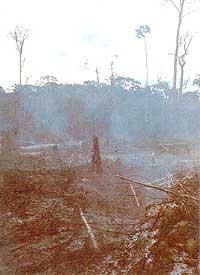New pastures in arid South American lands
The increase in the South American population will generate a greater need for meat and milk, so farmers can have a great importance. The poorest families in Kolombia spend at least a quarter of their profits on meat and milk.
In recent years the problem has been aggravated by the influx of people from outside to cities. Migration in South America has increased good agricultural land around cities.

In Colombia, however, farmers continue to live in their poor lands. The lands of the plains, savannas or tropical forests are becoming more fertile. Funding is what drives farmers to such areas, as land is very poor and therefore large amounts of fertilizer are needed. Poor peasants burn part of the tropical forests so that the land has organic matter. But this fertilizer runs out for a year in intensive agriculture.
However, savannah lands and tropical forests are increasingly used in agriculture. In 1950, for example, the territory of the Cauca Valley, with the best lands of Kolombia, supplied 7.4% of the food for livestock, a percentage that in 1985 was reduced to 2.2%.
10 years ago, the agricultural research institution of Kolombia, together with the CIAT (International Center for Tropical Agriculture), initiated a plan to improve the plains and lands without forests. Then the organization called RIEPT was created. The goal is to turn the tropical lands of South America into grasslands.
One of the main ideas of CIAT within its program is the union of crops and herbs, that is, the shift planting. This normal rotation in Europe is recent in South America for farmers in the area. The crop initially supplies the nitrate needed by the herb. Subsequently, plant or animal waste affects microbiological activity, gradually generating a dependence between fauna and flora.
The livestock that the cereal/grass pair can have per hectare is higher than that which can only have grass, that is, if in the first situation they can have four animals, in the second three.
To the above mentioned problems we must add others. Small farmers have occupied land where mamioca, alubia, corn, coffee and tomato grow.
Actually, the earth is red, by the action of aluminum and iron oxide. These two substances are poisonous to plants. In these lands there is no phosphorus and they have little nitrate. Measured on an arid earth scale, scientists say they are the ones before the worst.
In addition, these lands have suffered a strong erosion. Therefore, it is necessary to put obstacles to erosion and to achieve this it must act as a layer of grass. But the scarcity of economic resources forces farmers to obtain a layer of grass without fertilizer.
Therefore, CIAT researchers have opted for the cereal/grass couple looking for the most appropriate species for it. In the field of grass three types of grass are disputed ( Brachiaria decumbens, Brachiaria humidicola, Brachiaria dictyoneura) and two types of cultivation in the crop ( Desmodium ovalifolium and Arachis pintoi). In the end it seems that depending on the soil we will have to resort to mixed solutions, since some need more fertilizers than others.
Although the economic aspect will limit the selection, we hope not to condition too much the local ecological balance.
Buletina
Bidali zure helbide elektronikoa eta jaso asteroko buletina zure sarrera-ontzian










